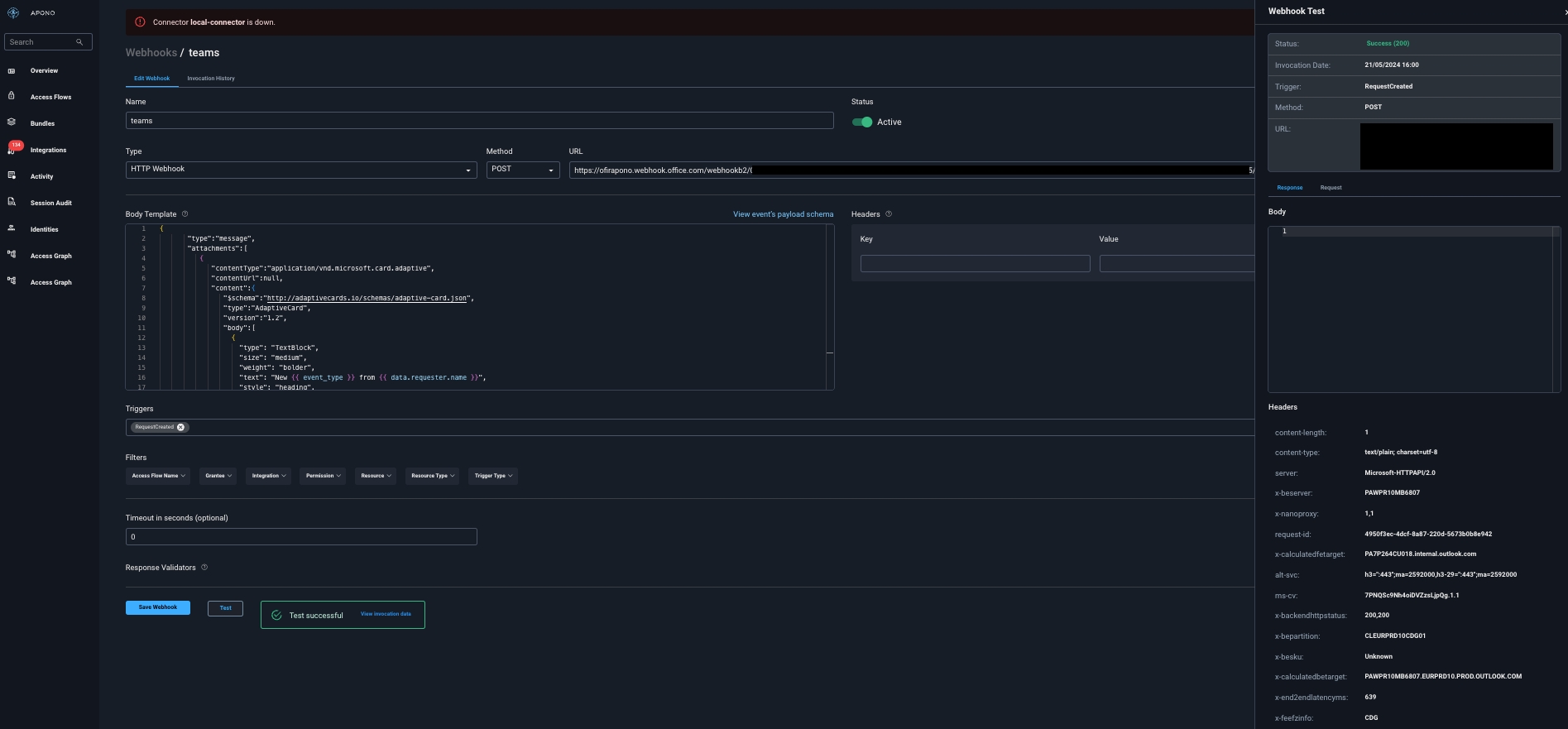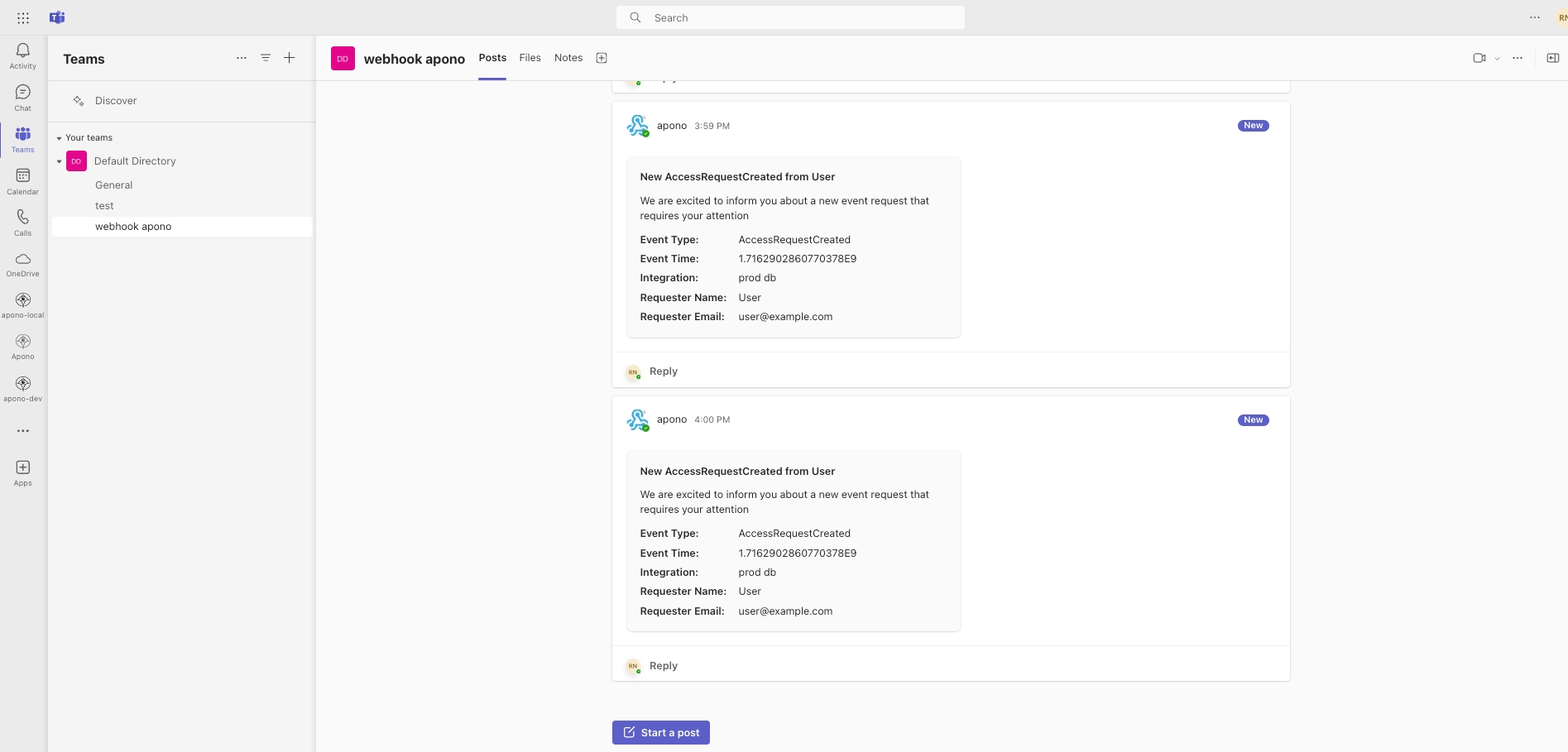Teams
Send Apono access requests data to Teams channels triggered by Apono requests events
Microsoft Teams is a collaboration platform by Microsoft that integrates chat, video conferencing, file storage, and application integration for streamlined teamwork.
Leveraging Apono's webhooks solution, you can send requests' data to a dedicated Teams channel as access is requested, granted and revoked.
Prerequisites
Teams account with an active Subscription (Create an Teams account here).
Create a webhook
Follow these steps to configure a webhook:
On the Webhooks page, click Add Webhook. The Add Webhook page appears.
Click Request Webhook.
Enter a unique, alphanumeric, user-friendly Request Webhook Name for identifying this webhook.
Click the Status toggle to Active.
From the Method dropdown menu, select POST.
In the URL field, enter the incoming webhook URL.
The webhook URL must adhere to the following requirements:
Uses the HTTPS protocol
Does not specify any custom ports
In the Body Template field, construct a JSON body for the webhook payload.
{
"type":"message",
"attachments":[
{
"contentType":"application/vnd.microsoft.card.adaptive",
"contentUrl":null,
"content":{
"$schema":"http://adaptivecards.io/schemas/adaptive-card.json",
"type":"AdaptiveCard",
"version":"1.2",
"body":[
{
"type": "TextBlock",
"size": "medium",
"weight": "bolder",
"text": "New {{ event_type }} from {{ data.requester.name }}",
"style": "heading",
"wrap": true
},
{
"type": "TextBlock",
"text": "We are excited to inform you about a new event request that requires your attention",
"wrap": true
},
{
"type": "FactSet",
"facts": [
{
"title": "Event Type:",
"value": "{{event_type}}"
},
{
"title": "Event Time:",
"value": "{{event_time}}"
},
{
"title": "Integration:",
"value": "{{data.access_groups.[0].integration.name}}"
},
{
"title": "Requester Name:",
"value": "{{data.requester.name}}"
},
{
"title": "Requester Email:",
"value": "{{data.requester.email}}"
}
]
}
]
}
}
]
}Click View event's payload schema to reveal the payload schema and available data fields. You can also refer to the Webhook Payload Schema Reference to read the descriptions of each data field.
From the Triggers dropdown menu, select one or more of the following event triggers, which correspond to Apono access request statuses:
RequestCreated
RequestApproved
RequestExpired
RequestFailed
RequestGranted
RequestRejected
Under Filters, define one or several filter from the listed dropdown menus.
(Optional) In the Timeout in seconds field, enter the duration in seconds to wait before marking the request as failed.
(Optional) Define Response Validators to verify that the response from the webhook meets specified criteria:
Click + Add. A row of settings appears.
Starting with $.data., enter the Json Path of the JSON parameter.
In the Expected Values field, enter a value and press the Enter key on your keyboard.
Repeat step c to add several expected values.
Repeat steps a-d to add multiple response validators.
Click Test to generate a test event to trigger your webhook. A Test successful or Test failed response status will appear at the bottom of the page. A successful test will send mock data to the target system.
For more information about the test, click View Invocation Data. A panel opens revealing the request, response, and other relevant details.
Should your test fail, view these tips to troubleshoot your webhook.
Click Save Webhook.
The new webhook appears in the Webhooks table. Active webhooks are preceded by a green dot. Inactive webhooks are preceded by a white dot.
Apono access request logs will be sent to Teams based on the triggers you have selected.
Results
Your webhook should now start sending request event message to your Teams channel once triggered:


Last updated
Was this helpful?
